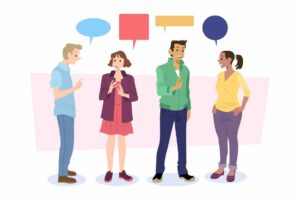What is Conversation?
A conversation is an interaction using words between two or more persons. It can happen with individuals present in the same place or distantly using electronic or mechanical devices.
It is an exchange of views, ideas, and information between a speaker and a listener. The two parties interact by relaying information through speech.
Conversations are a vital part of life as they help establish, maintain and strengthen relationships.
Conversations are used for:
- Self-expression
- Building trust
- Getting to know others
- Exchange of information
What is Communication?
Communication is a key ingredient in human life. It refers to the exchange of information, ideas, and messages between a sender and receiver. The information is conveyed using a medium, which is used by the sender to deliver the message to the receiver.
Related Reading: Elements of Communication Process & Communication Cycle
The medium used to communicate information can be:
- Verbal communication: conversations, voice notes, phone calls, video calls, etc.
- Non-verbal communication: letters, emails, Informal business reports, notes, etc.
Related Reading: Benefits and limitations of verbal communication
What is the difference between Conversation and Communication
The purpose of both conversation and communication is the exchange of ideas and messages between a sender and receiver. However, communication is a broad field that makes use of different mediums. A conversation is a verbal medium of communication.
The key differences between a conversation and communication are:
1) Organizational Structure: Forms of communication such as reports, public speeches, etc. follow a more organized structure than a regular conversation.
The speaker organizes their thoughts and presents them with three elements in mind: introduction, body, and conclusion. Conversations, on the other hand, can wander and not have any kind of conclusion.
2) Use of Formal Language: Another big communication and conversation difference is the usage of formal language. A conversation can be informal and casual in its tone. For example, when talking to a friend, there is no pressure to sound professional and end with a clear conclusion.
Communication channels often require the speaker to be eloquent and use formal language to convey their thoughts. The content is designed to achieve a specific goal – to educate, inform, entertain, influence, etc. The speaker must follow a certain formality in their speech or writing according to their audience.
3) Delivery Method: Conversations can be spontaneous and happen without any preparation. A person can randomly approach someone and “strike up a conversation”.
Communication methods such as reports and speeches require the sender to prepare beforehand. They must know the subject matter and deliver it in a convincing way for effective communication.
4) Delayed Feedback: A face-to-face conversation with another person is interactive. The individuals part of the conversation can exchange thoughts and ideas and receive feedback immediately.
This is not possible with certain forms of communication such as letters, reports, etc. The sender must wait for the receiver to decode their message and respond back to them. This process can take hours or even days.
5) Timing: Communication forms such as a public speech may have to abide by time constraints and follow a set fixed schedule. Conversations can happen at any time. The length of a conversation can be long or short depending on the willingness of the participants.
Communication Vs Conversation: The difference table
Difference | Communication | Conversation |
Strucutre | Communication are more structured. | Conversation can have free flow. |
Use of Formal Language | Communication are gernally followed by formal tone. | Conversation can be casual as well as informal in tone. |
Delivery Method | Communication are offen planned. | Conversation are spontenous |
Delayed Feedback | Feedback can delayed dending on the type of communication used. | Offer imidiate feedback. |
Timing | Communication can have time constrains. | Conversation can last for hours. |
Similarities between Communication and Conversation
The similarities shared between communication and conversation are as follows:
1) Involves a speaker and listener: The main commonality between a conversation and various forms of communication is that they both involve a speaker conveying information and a listener receiving it and vice versa.
2) Common purpose: Both communication and conversation share the same purpose: to convey information, ideas, and messages.
3) Interactive nature: Communication is an interactive exchange of information between a sender and receiver. A conversation and any form of communication are incomplete without the speaker and listener interacting.
4) Using a common language: The objective of a conversation and communication is to reach mutual understanding. The common medium used in both communication and conversation is a shared language by both sender and receiver.
How to communicate effectively?
Effective communication is essential for network building, being liked, and sharing mutual understanding.
To communicate effectively, keep the following in mind:
- Two-Way Channel: For communication to be effective, it should be encouraged for both parties involved to participate and interact. The sender of the information must welcome feedback from the receiver.
- Being a good listener: A good communicator also needs to be a good listener. They must give the receiver a chance to convey their thoughts and listen carefully before speaking.
- Appropriate language: For maximum efficiency in communication, the speaker should speak in a language or use means such as symbols, pictures, etc that their audience is familiar with.
- Communicators must have credibility: The individual communicating can only expect the listener to positively react to their message if they are considered trustworthy. The communicator must build a good reputation to make their message credible to their audience.
How to have an effective conversation?
In any conversation, it is important to keep in mind what is said and how it is said. Using the right words and tone can go a long way in having a positive interaction.
Consider the following strategies for having an effective conversation:
- Start on a positive note: Starting a conversation with a genuine compliment or positive statement helps in building a good connection with the listener. This makes the listener more comfortable and more likely to respond positively.
- Let the other person talk: A good conversation has two-way traffic. A speaker must invite participation from their listener and give them the opportunity to share their viewpoints and feedback.
- Maintain a friendly tone: Disagreements can often occur during a conversation. It is important to always be polite and handle them in a friendly manner.
- Refrain from offering unsolicited advice: Offering unsolicited advice can be received negatively. It is important for the speaker to keep this in mind and be mindful of the listener.
Which is more effective?
It is rightly said that man is a social animal. Human interactions are heavily made up of conversations and various forms of communication such as letters, notes, text messages, etc.
Both are crucial parts of getting across ideas and information in an interactive manner. A conversation or any other means of communication can help in building stronger relationships, networking, achieving common goals, etc.
It is situation-specific whether to use a conversation or another means of communication such as written communication. Both are effective and can achieve the desired purpose.
Related Read: Pros and Cons of written communication



